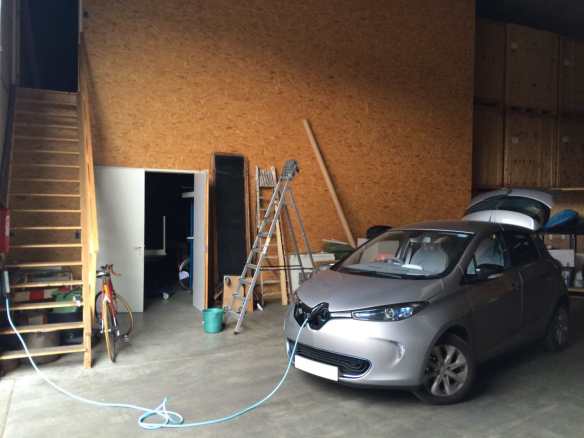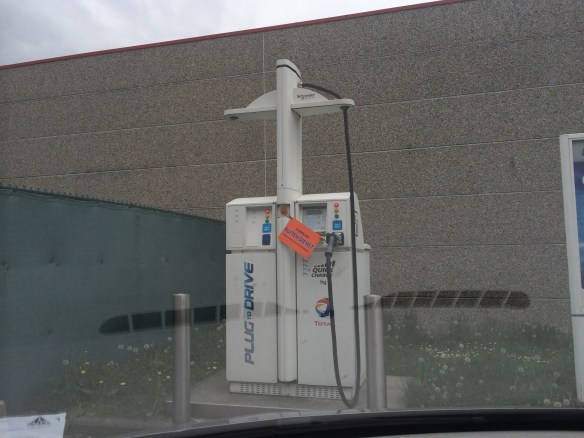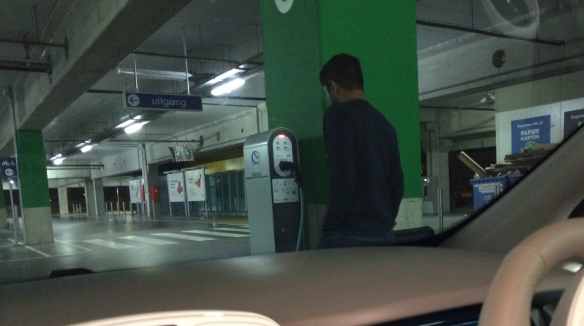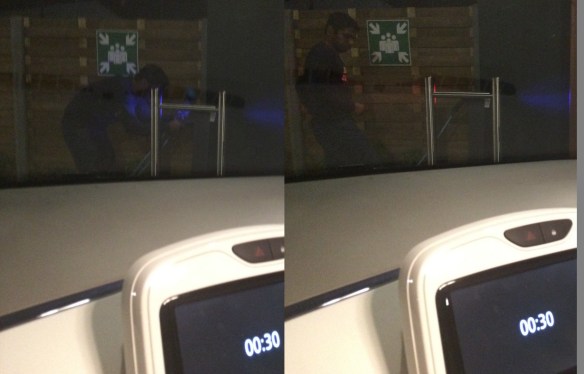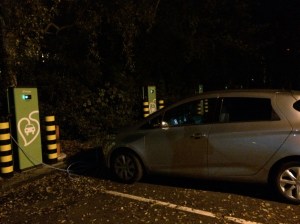This is Part 2, you’ll want to read part 1 (The Plan) first.
We prepared for this electric road trip across five countries in a day in the way all ambitious electric road trippers should – by painting the bathroom late into the night before we set off. To be fair, there was some method to this madness, in that the paint fumes should have dissipated while we were away. Still, I probably moaned just a little bit.
The plan was to set off pretty early (4am) as we needed to get to Belgium during office hours in order to pick up both the beCharged (in Ghent) and Blue Corner (in Antwerp) charger network cards. Our channel crossing on the Eurostar was booked for 10am, but we needed to fit in 2 charges on the 140 mile trip to Folkestone – both at slow Polar charging points (2ish hours each) as the only fast charger on the route (Ecotricity on the M25 Westerham) was showing as offline on the live map. We also needed to fit in a full charge in Folkestone before crossing over to France, as we didn’t have a clue what the charging situation would be like in France.
So, 4am and off we went. Rather uneventful and yawn-ey first leg to the Royal Horticultural Society in Wisley, arriving there to the welcoming charger LED glow shortly before dawn broke.
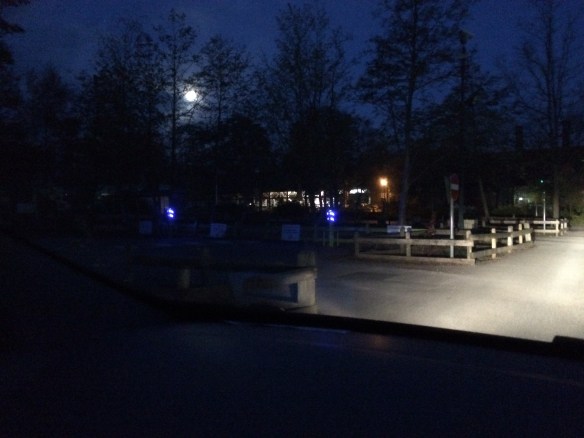
the welcoming glow of a working charging point
Some minor drama getting the charge started – my Polar card didn’t work for some reason unbeknownst to me. Then tried the Polar Instant iPhone app as backup – but of course I had no signal for the app to connect, even with various creative poses arms akimbo in the cold, dark morning. Finally tried the Source London card, and it graciously popped open a charge point for me to plug in to. Success (eventually)!
My grumpy co-pilot had a nap in the back seat while we charged for an hour or so, while I got to take in the sunrise while working out the finer details for the rest of our route.
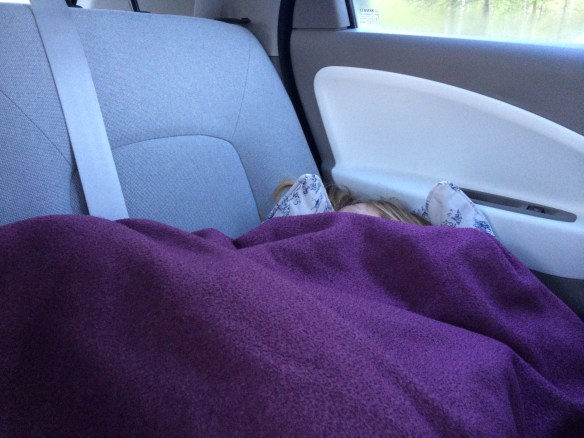
Back on the M25 fully charged, and heading for Folkestone. Despite the Ecotricity live map showing the M25 Westerham services fast charger was offline, we needed to stop there anyway for my squirrel-bladdered co-pilot. Pulled up to the charger on a whim, and lo and behold the darn thing is working! Quick tweet to let Ecotricity know.
Sneaked in a pee-and-coffee-long fast charge there before heading for the Renault dealership in Folkestone, for what was to be our final fullish charge UK-side before crossing the Channel.
Alas, ’twas not meant to be. Despite ZapMap and the Renault live map (since discontinued?) showing an active charge point at the dealership there, we were met with blank expressions when we arrived… DOH! @RenaultUK tweet confirmed this was a map error 
Pretty low on charge now, but no other practical charging options – so off to the Tunnel, we’d have to figure this out in Franceland. We did manage to get the requisite Europe emergency kit at Renault though – the hi-viz jacket, GB sticker, emergency breakdown pack that you need to keep in arm’s reach when travelling through Europe.
Arriving at the Eurotunnel earlier than scheduled does offer some flexibility, as the check in system offers an earlier departure if possible. Thank you very much, don’t mind if we do! More time to sort things out on the other end. Onto the train then!
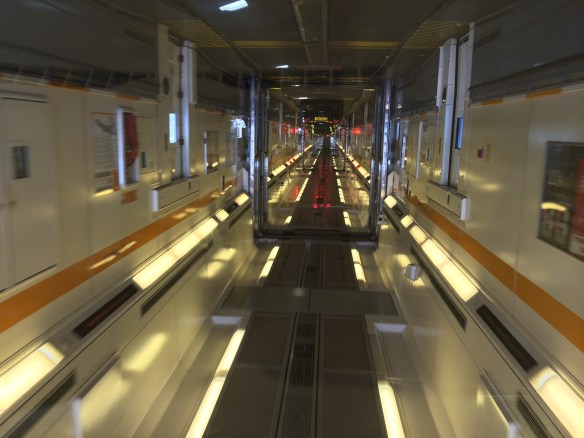
yeah, it’s upside down, but I like it
A mere 35 minutes under the sea, and Zoe is in France. I like road tripping, and I like trains. Combined, this is doubly delightful!
First stop was the Cité Europe mall parking in the Coquelles district of Calais – ChargeMap.com, a sort-of crowd-sourced user-curated charger map indicated charging points here, without sufficient info for us to figure out whether these would be compatible chargers (ie. if they were Mennekes Type 2 connectors). Got there to discover these charging points were literally just normal Euorpean plug points in the parking lot. 
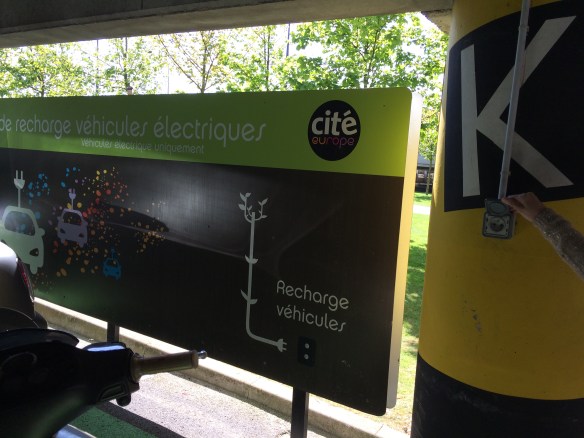
No help there then. We didn’t have a normal wall outlet charger, sometimes called a granny-charger (ie. the charger you can use on those occasions when you go visit your granny – just plug in to the normal wall outlet, slow charge). These weren’t available in the UK yet, though rumour had it that you could buy them in Europe.
Next stop, off to the Renault dealership in Calais, a mile or so away. With our poor French and the Frenchies’ aversion to speaking English, we battled through convincing the Renault chaps to both lend us their charger RFID card, and to lend us a cable from one of their demo Zoe’s so we could get charged. Between us, the wife and I are pretty fluent in German, Dutch, Spanish and English (of that list, I contribute only English 😉 ). Still, none of these were of any help with the French 
The reason we needed to hassle a cable off the Frenchies was that the French use an entirely different plug type to the rest of Europe – so our “standard” Mennekes Type 2 cable was useless for their charging infrastructure. Apparently some old French law required that all public electrical sockets need to have a cover over them, to prevent electrocution from people touching the charge points (despite electric circuitry having long since solved this problem in a more elegant and reliable fashion). So the French insisted on using the Type 3 connector, more specifically an “EV Alliance Type 3C” connector.

Mennekes Type 2 on the left, EV Alliance Type 3C on the right
This meant we would have to beg, borrow or steal charging cables in France, until we got to Belgium where sanity and the Type 2 connectors prevailed again.
Update: since this trip, the EU Commission has standardised on the Mennekes Type 2 connectors across the EU, so France is (hopefully) now using the common standard too.
Having finally pried a cable and a RFID card from the Renault chaps, we head outside to their charger and try to get started. More problems: charging starts briefly, then stops. Blinkey lights on the charger for a while. Try a few more times, same (failed) result. Eventually got a few Renault technicians outside, all scratching heads rather Frenchily…
The situation is now rather bleak, we don’t have enough range to get to the next charging location, and this one seems poked. The techies figure its a fault on the charger, and they’ll have someone look at it the following week – of course no help to us. Even worse, these delays here mean we won’t make it to the two Belgian companies to pick up our charge cards for before the Easter weekend starts, so that kills all further charging possibilities in Europe… “Eish” is an appropriate South African term for such a situation.
During all of this, my somewhat sceptical wife has been observing the going-ons from an appropriate vantage point, with the gravity of the situation slowly settling in. Right about this moment of realised hopelessness, she kicks into gear, stomping over muttering something along the lines of “.. it’s just a stupid computer…”. The Renault techies and I cautiously back away. She gets up to the charger and starts poking at prodding at its 2 or 3 button interface, still muttering. We cringe, I think we might have even huddled together in our collective failure, quaking…
Then, as if circuitry and electronics could cower and submit before the wrath of the woman scorned… VIOLA!!! the darn thing starts charging! Disaster averted!!
Celebrations all round, the Frenchies wander off, regaling each other with tales of their near miss. While waiting for the charge (2 hours) we grab some lunch nearby, and importantly manage to buy a granny charger (also called a Flexi Charger) from the Renault spares shop (another mission, they didn’t know what I was talking about, and then didn’t know they had one). The granny charger was an all-important acquisition, as it now meant we could charge at any domestic socket (albeit incredibly slowly, at around 16 hours for a fullish charge).
Charged, fed, and equipped with a new means to charge, spirits were up as we left Calais, on our way to Dunkirk, and another Renault dealer there – for a last charge in France before making a bee-line for Ghent, Belgium where we were to pick up the first of our charge cards.
Friendlier folk at Renault Dunkirk were much more helpful with the charge – success despite being ICE’d (charging spot occupied by an Internal Combustion Engine vehicle) rather uniquely by a CRANE.
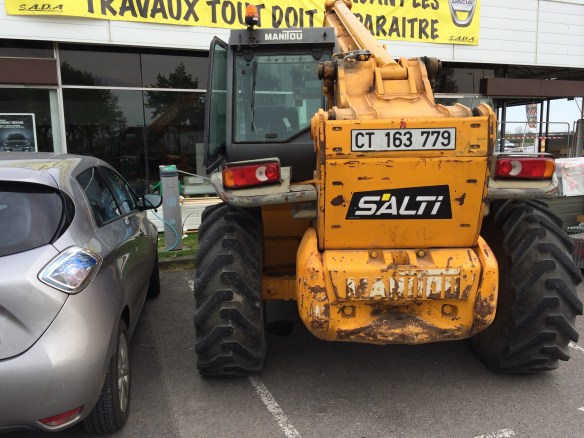
errr… a rather serious ICEr
It was time to get a jiggle on, the Calais shenanigans had cost valuable time, and we needed to make the Belgian meetings to pick up cards before they closed for Easter weekend. I contacted the Ghent-based beCharged to apologise for the delay, and a friendly developer there was prepared to wait for us, and agreed to let us charge at their test points there, meaning we could skip a planned charge point in between. Sweet!
Dunkirk to Ghent was uneventful (and a nice part of the drive) and we made it to beCharged on time. Simon the friendly developer greeted us there with the charge card which would allow us to charge at their locations in Belgium. We hooked up to their test charge infrastructure, hoping to do a fast charge – but alas it was not meant to be. The Zoe was pretty new back then, and the Chameleon charger worked a bit differently to previous tech – so Simon did some live debugging to collect the info he needed while we charged.

beCharged debugging fast charge issues
We now ended up with one of those quandaries every EV driver will face when charging in a hurry: we needed to charge enough to get to our next destination in time – charge too long, and we’d be late and miss the opportunity to pick up the important roaming RFID charge card from Blue Corner. But charge too short, and we risk not making it to our destination at all. To complicate the delicate calculations further, if we were rushing to get there and driving faster, we consume power at a greater rate… higher consumption meaning lower range, and the risk again of not making it to destination.
Having run the calculations factoring in expected travel time (accounting for traffic), distance (range required), estimated consumption rate and current rate of charge we settled on the sweet spot, the perfect cut off time to give us the best chance of making our destination on time with sufficient range. Bang on the calculated minute we stopped the charge, thanked helpful Simon and legged it in the direction of Antwerp.
Now, when travelling at speed on the motorway, most of the energy consumption goes to just overcoming air resistance – energy required to punch the vehicle through the air. So where possible, I’ve tried slipstreaming larger vehicles to minimise drag, in the hopes that this ekes out some additional range. Of course riding up the butt of a tanker truck did tend to make the co-pilot somewhat nervous, so this technique had to be used sparingly.
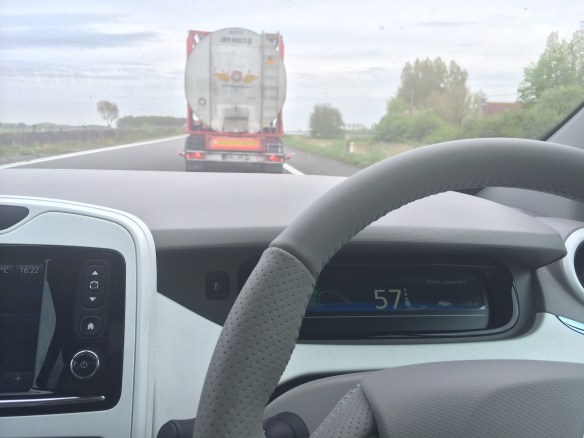
slipsteam
It became clear as we barrelled towards Antwerp that we weren’t going to make it. We were consuming power at a greater rate than anticipated, perhaps a headwind, slight climb, the cooler temperature, or the slowing and speeding up in traffic – whatever it was, we were going to be a few miles short… and there were no known charging points between us and our (now unreachable) destination.
Time to test this granny charger then! We had to give up on making our Antwerp appointment with Blue Corner, and instead stop at a motorway services, right on the outskirts of Antwerp – hoping for a slow granny charge. Fortunately the services ladies were charmed by my winning smile 🙂 and they let us park right outside the door and charge there.
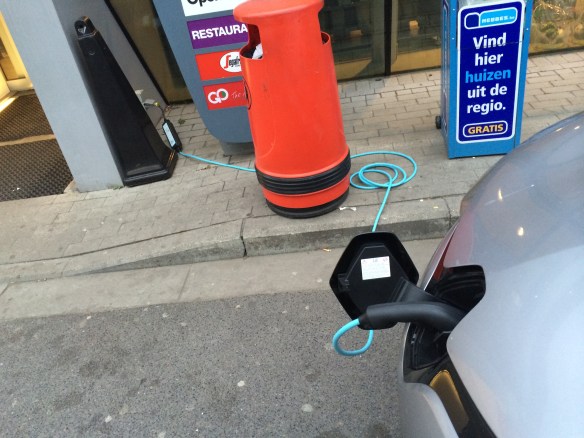
motorway services granny charge
The granny charger is painfully slow – it was going to take almost 2 hours just to add the few miles we needed to get to the centre of Antwerp. Time aplenty for some motorway services dinner, and to contact the Blue Corner folk to let them know we were not going to make it. Fortunately, they were quite understanding, and agreed to pop the charger RFID card in an envelope at a nearby services convenience store for us to pick up that night (I had already paid for it from the UK).
Eventually got in just enough charge to make the chargers at Antwerp train station in the city centre, and headed off. A bit of trouble finding the chargers in a massive carpark, and finally limped to the chargers with a fully depleted battery…

zero miles to go
It was almost 10:30pm by then, and even though we were just one hop from our final destination in the Netherlands, it would take over 2 hours to charge enough to make it there. Being the wise man I am, I knew better than to suggest to my sceptical co-pilot that we soldier on after midnight… actually, no… I think I may have been dumbass enough to suggest it – but that turned out to be a very short conversation.
So we decided to call it a day, checked in at a hotel nearby and gave up on the do-it-all-in-a-day idea. It was time for a Very Large Vodka Indeed.
The rest of the journey was positively pleasant without the time pressure. Starting off fully charged from Antwerp, our first charge spot was at the super interesting Kamp C, a government funded centre for sustainable living where we were able to check out some eco-builds and be impressed with how progressive the Belgians were about practical support for citizens wanting to build and live greener.

you can just about make out Zoe charging on the right edge
Once over the border to the Netherlands, charging was a breeze. The Blue Corner card we got in Belgium allowed roaming in the Netherlands, and the Dutchies were totally sorted with EV charging. The Netherlands (then already) had TWICE the number of EV charging points than the UK, with only a QUARTER of the population. Pretty much everywhere we went we had charging opportunities, even the tiniest out of the way villages.
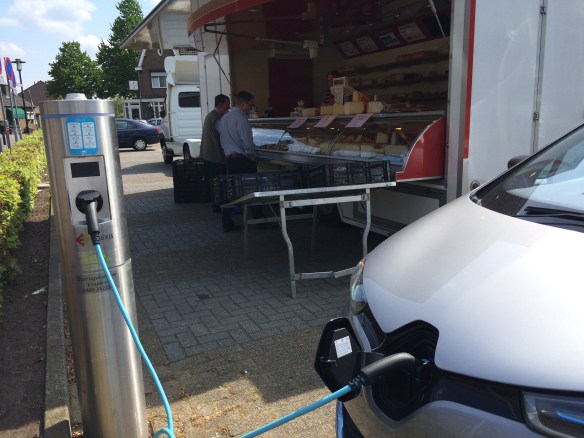
charge and cheese ?
Onwards to Germany – where we only ever experienced one charger at our hotel in Düsseldorf (chosen for it’s charger availability) – but this didn’t even require an RFID card. If memory serves, this might have been quite widespread in Germany, free charging without an account or RFID card.
The next day, we were going to try to get back to Oxford – across 5 countries. But that’s a story for part 3 – first an afternoon of German beer and an evening out to see what Düsseldorf had to offer.

